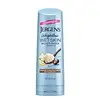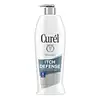What's inside
What's inside
 Key Ingredients
Key Ingredients

 Benefits
Benefits

 Concerns
Concerns

 Ingredients Side-by-side
Ingredients Side-by-side

Water
Skin ConditioningGlycerin
HumectantParaffinum Liquidum
EmollientEthylhexyl Isononanoate
EmollientPetrolatum
EmollientButyrospermum Parkii Butter
Skin ConditioningTheobroma Cacao Seed Butter
EmollientCetearyl Alcohol
EmollientEthylene/Propylene/Styrene Copolymer
Acrylates/C10-30 Alkyl Acrylate Crosspolymer
Emulsion StabilisingParfum
MaskingCeteareth-20
CleansingButylene/Ethylene/Styrene Copolymer
Magnesium Aluminum Silicate
AbsorbentButyrospermum Parkii Oil
EmollientSodium Hydroxide
BufferingTocopheryl Acetate
AntioxidantHyaluronic Acid
HumectantSodium Hyaluronate
HumectantMethylparaben
PreservativePhenoxyethanol
PreservativeEthylparaben
PreservativeCaramel
Cosmetic ColorantWater, Glycerin, Paraffinum Liquidum, Ethylhexyl Isononanoate, Petrolatum, Butyrospermum Parkii Butter, Theobroma Cacao Seed Butter, Cetearyl Alcohol, Ethylene/Propylene/Styrene Copolymer, Acrylates/C10-30 Alkyl Acrylate Crosspolymer, Parfum, Ceteareth-20, Butylene/Ethylene/Styrene Copolymer, Magnesium Aluminum Silicate, Butyrospermum Parkii Oil, Sodium Hydroxide, Tocopheryl Acetate, Hyaluronic Acid, Sodium Hyaluronate, Methylparaben, Phenoxyethanol, Ethylparaben, Caramel
Water
Skin ConditioningGlycerin
HumectantPetrolatum
EmollientTapioca Starch
Cetearyl Alcohol
EmollientPEG/PPG-17/6 Copolymer
SolventDimethicone
EmollientBehentrimonium Chloride
PreservativeIsopropyl Palmitate
EmollientPPG-15 Stearyl Ether
EmollientPropylene Glycol Isostearate
Skin ConditioningPanthenol
Skin ConditioningIsopropyl Alcohol
SolventMethylparaben
PreservativeBenzalkonium Chloride
AntimicrobialEthylparaben
PreservativeOlea Europaea Fruit Oil
MaskingCetyl-Pg Hydroxyethyl Palmitamide
Skin ConditioningBis-Methoxypropylamido Isodocosane
EmollientButyrospermum Parkii Butter
Skin ConditioningSodium Lauroyl Lactylate
EmulsifyingTocopheryl Acetate
AntioxidantCeramide NP
Skin ConditioningCeramide AP
Skin ConditioningCholesterol
EmollientPhytosphingosine
Skin ConditioningCarbomer
Emulsion StabilisingXanthan Gum
EmulsifyingCeramide EOP
Skin ConditioningWater, Glycerin, Petrolatum, Tapioca Starch, Cetearyl Alcohol, PEG/PPG-17/6 Copolymer, Dimethicone, Behentrimonium Chloride, Isopropyl Palmitate, PPG-15 Stearyl Ether, Propylene Glycol Isostearate, Panthenol, Isopropyl Alcohol, Methylparaben, Benzalkonium Chloride, Ethylparaben, Olea Europaea Fruit Oil, Cetyl-Pg Hydroxyethyl Palmitamide, Bis-Methoxypropylamido Isodocosane, Butyrospermum Parkii Butter, Sodium Lauroyl Lactylate, Tocopheryl Acetate, Ceramide NP, Ceramide AP, Cholesterol, Phytosphingosine, Carbomer, Xanthan Gum, Ceramide EOP
Ingredients Explained
These ingredients are found in both products.
Ingredients higher up in an ingredient list are typically present in a larger amount.
This ingredient is also known as shea butter. It is an effective skin hydrator and emollient.
Emollients help soothe and soften your skin. It does this by creating a protective film on your skin. This barrier helps trap moisture and keeps your skin hydrated. Emollients may be effective at treating dry or itchy skin.
Shea butter is rich in antioxidants. Antioxidants help fight free-radicals, or molecules that may harm the body. It is also full of fatty acids including stearic acid and linoleic acid. These acids help replenish the skin and keep skin moisturized.
While Shea Butter has an SPF rating of about 3-4, it is not a sunscreen replacement.
Shea butter may not be fungal acne safe. We recommend speaking with a professional if you have any concerns.
Learn more about Butyrospermum Parkii ButterCetearyl alcohol is a mixture of two fatty alcohols: cetyl alcohol and stearyl alcohol. It is mainly used as an emulsifier. Emulsifiers help prevent the separation of oils and products. Due to its composition, it can also be used to thicken a product or help create foam.
Cetearyl alcohol is an emollient. Emollients help soothe and hydrate the skin by trapping moisture.
Studies show Cetearyl alcohol is non-toxic and non-irritating. The FDA allows products labeled "alcohol-free" to have fatty alcohols.
This ingredient is usually derived from plant oils such as palm, vegetable, or coconut oils. There is debate on whether this ingredient will cause acne.
Due to the fatty acid base, this ingredient may not be Malassezia folliculitis safe.
Learn more about Cetearyl AlcoholEthylparaben is a preservative, is a paraben, and is not reef safe.
Glycerin is already naturally found in your skin. It helps moisturize and protect your skin.
A study from 2016 found glycerin to be more effective as a humectant than AHAs and hyaluronic acid.
As a humectant, it helps the skin stay hydrated by pulling moisture to your skin. The low molecular weight of glycerin allows it to pull moisture into the deeper layers of your skin.
Hydrated skin improves your skin barrier; Your skin barrier helps protect against irritants and bacteria.
Glycerin has also been found to have antimicrobial and antiviral properties. Due to these properties, glycerin is often used in wound and burn treatments.
In cosmetics, glycerin is usually derived from plants such as soybean or palm. However, it can also be sourced from animals, such as tallow or animal fat.
This ingredient is organic, colorless, odorless, and non-toxic.
Glycerin is the name for this ingredient in American English. British English uses Glycerol/Glycerine.
Learn more about GlycerinMethylparaben is a preservative and is a paraben. It is used to prevent the growth of fungus, mold, and other harmful bacteria. Parabens are chemicals used as preservatives in both cosmetics and food.
Methylparaben can be synthetically created. It can also be found naturally in some fruits, such as blueberries.
Oftentimes, Methylparaben is combined with other parabens to help increase the shelf life.
The safety of Methylparaben is currently being studied. While ongoing studies are looking into the safety of parabens, the results have been very mixed. Some studies have not found Methylparaben to be harmful.
Learn more about MethylparabenPetrolatum is more commonly known as petroleum jelly. It is created by mixing waxes and mineral oils.
This ingredient is effective at reducing water loss by 99%. This is because it is an occlusive. Occlusives create a hydrophobic barrier on the skin to prevent evaporation. This property makes it great for hydrating dry skin.
Pro tip: Use occlusives, such as this ingredient, on damp skin for the best results.
The quality or origin of petrolatum is only known when disclosed by the brand. Most cosmetic petrolatum has gone through several purification stages.
Another benefit of occlusives is it protects your skin against infection or allergies.
Petrolatum may not be safe for fungal-acne. Studies show mineral oil / petroleum leads to the growth of M. Furfur, a type of yeast.
Learn more about PetrolatumTocopheryl Acetate is AKA Vitamin E. It is an antioxidant and protects your skin from free radicals. Free radicals damage the skin by breaking down collagen.
One study found using Tocopheryl Acetate with Vitamin C decreased the number of sunburned cells.
Tocopheryl Acetate is commonly found in both skincare and dietary supplements.
Learn more about Tocopheryl AcetateWater. It's the most common cosmetic ingredient of all. You'll usually see it at the top of ingredient lists, meaning that it makes up the largest part of the product.
So why is it so popular? Water most often acts as a solvent - this means that it helps dissolve other ingredients into the formulation.
You'll also recognize water as that liquid we all need to stay alive. If you see this, drink a glass of water. Stay hydrated!
Learn more about Water